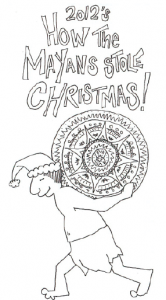A close look at end-of-the-world theories

If you are reading this, you have survived. The ending of the ancient Mayan long count calendar did not cause the earth to implode or otherwise come to an end, as purported by that one weird guy in class, or the crazy hobo on the corner, or every survivalist community getting their flash of relevancy that comes on the tail of every doomsday theory. It’s all right if you were maybe a little worried though; I too had moments where I would trail off in thoughts of, what if? What if the earth was consumed by a black hole? What if the earth’s rotation suddenly reversed? What if the planet Niburu really is on a collision course with our wonderful planet?
The answer is, we would likely be dead and it wouldn’t matter, but these are all actual theories of what was going to happen on December 21, 2012, found on just a few of over one million websites mentioning the date as the possible end of the world (please see www.squidoo.com or www.EscapeEarth2012.com if you would like further information). It is easy to think through these theories on your own and conclude that they are worthy of the ridicule they should well be receiving. Take the planet Niburu for example, supposedly discovered by the Sumerians, it was first sourced as the end of the earth in May 2003 by Nancy Lieder, a woman that claims the ability to receive messages from aliens through an implant in her brain. When it became clear that Lieder’s prediction was incorrect, those that clung to the idea simply moved the date to coincide with the end of the Mayan calendar.
Let’s think about our own calendars for a second. What would you say to someone that looked at a simple twelve month calendar, one with baby animals for each month, who became distracted by the cuteness of a white kitten in a festively-flocked basket, but saw that on December 31, the calendar was over and they became convinced that was the representation of the end of the world? I hope you would explain to them that calendars are cyclical and begin again every 365 days. No one was kind enough to explain the similar cyclical nature to the person(s) who decided that the ending of one Mayan calendar meant the world was over. Now we live in a world that created the movie “2012,” a strange amalgamation of Mayan doomsday theory, government conspiracies against the masses and climate science, where meteors fall on John Cusack’s RV, but only half of it is damaged and he drives on to momentary safety.
Of course, this will not be the last time we all survive a day that someone shouted would be humanity’s last. Since 1990, we’ve made it through at least 50 such events, about two doomsday’s per year. We made it through Y2K and Louis Farrakhan’s claim the the Gulf War meant Armageddon, but don’t let all of this “surviving” go to your head. Humanity does face problems that threaten our future existence, they just don’t involve ancient psychics or humanity realizing that world leaders are in fact a reptilian alien race (google David Icke if you would like to discover more about the British royals and their alien ancestry). We shouldn’t be wasting energy worrying if a culture thousands of years ago correctly predicted the end of time. We have real problems, right now, that need our rational and thoughtful attention: amplified climate change, a booming world population and rapidly diminishing natural resources. This world will end eventually; if humanity doesn’t siphon its every last resource, in a few billion years, the sun will engulf it in the later stages of its stellar evolution. So, if you would like to worry about the end of the world, the facts should be enough to stress anyone out. If you do not like worrying about the end of the world, stop watching the History Channel and get outside while it’s still there.







Leave a Reply